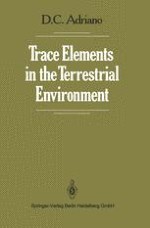1986 | OriginalPaper | Buchkapitel
Selenium
verfasst von : D. C. Adriano
Erschienen in: Trace Elements in the Terrestrial Environment
Verlag: Springer New York
Enthalten in: Professional Book Archive
Aktivieren Sie unsere intelligente Suche, um passende Fachinhalte oder Patente zu finden.
Wählen Sie Textabschnitte aus um mit Künstlicher Intelligenz passenden Patente zu finden. powered by
Markieren Sie Textabschnitte, um KI-gestützt weitere passende Inhalte zu finden. powered by
Selenium (atomic no. 34) is a member of Group VI, also known as the S family, in the periodic table. It has specific gravities of 4.79 g/cm3 for the metallic (gray) form, or 4.28 g/cm3 for the vitreous (black) form. It has an atomic weight of 78.96, melting point of (gray form) 217°C, and boiling point of (gray form) 684.9 ± 1°C. Because of its chemical similarity to S, it resembles S both in its forms and compounds and accounts for their many interrelations in biology. It has six stable isotopes in nature with the following percentage isotopic composition: 74Se, 0.87; 76Se, 9.02; 77Se, 7.58; 78Se, 23.52; 80Se, 49.82; and 82Se, 9.19. The most important oxidation states of Se are — II, II, IV, and VI. Selenium can be easily oxidized from Se(0), elemental Se, to Se(IV), (SeO32−), and to Se(VI), (SeO42−). Selenites (SeO32−) are stable in alkaline to mildly acidic conditions and can be found in nature. Some of the known commercial Se compounds are H2Se, metallic selenides Se(— II), SeO2, H2SeO3, SeF4, Se2C12, and H2SeO4 (selenic acid). Selenium also forms a large number of organic compounds that are analogous to those of S.
